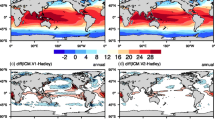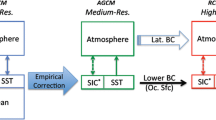Abstract
This work documents the diversity in Coupled Model Inter-comparison Project Phase 5 (CMIP5) models in simulating different aspects of sea surface temperature (SST) variability, particularly those associated with the El Niño–Southern Oscillation (ENSO), as well as the impact of low-frequency variations on the ENSO variability and its global teleconnection. The historical simulations (1870–2005) include 10 models with ensemble member ranging from 3 to 10 that are forced with observed atmospheric composition changes reflecting both natural and anthropogenic forcings. It is shown that the majority of the CMIP5 models capture the relative large SST anomaly variance in the tropical central and eastern Pacific, as well as in North Pacific and North Atlantic. The frequency of ENSO is not well captured by almost all models, particularly for the period of 5–6 years. The low-frequency variations in SST caused by external forcings affect the SST variability and also modify the global teleconnection of ENSO. The models reproduce the global averaged SST low-frequency variations, particularly since 1970s. However, majority of the models are unable to correctly simulate the spatial pattern of the observed SST trends. These results suggest that it is still a challenge to reproduce the features of global historical SST variations with the state-of-the-art coupled general circulation model.









Similar content being viewed by others
References
Barnston AG, Tippett MK, L’Heureux ML, Li S, DeWitt DG (2012) Skill of real-time seasonal ENSO model predictions during 2002–2011—is our capability increasing? Bull Am Meteorol Soc 93(5):631–651
Collins M et al (2010) The impact of global warming on the tropical Pacific and El Niño. Nat Geosci 3(6):391–397. doi:10.1038/ngeo868
Deser C, Capotoni A, Sarvan R, Phillips A (2006) Tropical Pacific and Atlantic climate variability in CCSM3. J Clim 19:2451–2481
Deser C et al (2010) Twentieth century tropical sea surface temperature trends revisited. Geophys Res Lett 37:L10701. doi:10.1029/2010GL043321
Deser C, Phillips A, Bourdette V, Teng H (2012) Uncertainty in climate change projections: the role of internal variability. Clim Dyn 38(3–4):527–546. doi:10.1007/s00382-010-0977-x
Glantz MH (2000) Currents of change: El Niño and La Nina on climate and society. Cambridge University Press, Cambridge, p 253
Guilyardi E, Bellenger H, Collins M, Ferrett S, Cai W, Wittenberg A (2012) A first look at ENSO in CMIP5. CLIVAR Exch 17:29–32
Hoerling MP, Kumar A (2002) Atmospheric response patterns associated with tropical forcing. J Clim 15:2184–2203
Hu Z-Z, Kumar A, Jha B, Huang B (2012) An analysis of forced and internal variability in a warmer climate in CCSM3. J Clim 25(7):2356–2373. doi:10.1175/JCLI-D-11-00323.1
Jin F-F, Hu Z-Z, Latif M, Bengtsson L, Roeckner E (2001) Dynamics and cloud-radiation feedbacks in El Niño and greenhouse warming. Geophys Res Lett 28(8):1539–1542
L’Heureux M, Collins D, Hu Z-Z (2013) Linear trends in sea surface temperature of the tropical Pacific Ocean and implications for the El Niño-southern oscillation. Clim Dyn 40(5–6):1223–1236. doi:10.1007/s00382-012-1331-2
McPhaden MJ, Zebiak SE, Glantz MH (2006) ENSO as am integrating concept in earth science. Science 314:1739–1745
Meehl GA, Washington WM (1996) El Niño-like climate change in a model with increased atmospheric CO2 concentrations. Nature 382:56–60
Meehl GA, Stocker TF, Collins WD, Friedlingstein P, Gaye AT, Gregory JM, Kitoh A, Knutti R, Murphy JM, Noda A, Raper SCB, Watterson IG, Weaver AJ, Zhao Z-C (2007) Global climate projections. In: Solomon S, Qin D, Manning M, Chen Z, Marquis M, Averyt KB, Tignor M, Miller HL (eds) Climate change 2007: the physical science basis. Contribution of working group I to the fourth assessment report of the intergovernmental panel on climate change. Cambridge University Press, Cambridge, United Kingdom and New York, NY, USA
National Research Council (2010) Assessment of intraseasonal to interannual climate prediction and predictability. The National Academies Press, Washington, p 192. ISBN-10: 0-309-15183-X
Philander SG (1990) El Niño, La Niña and southern oscillation. Academic Press, San Diego, CA, p 293
Rasmusson EM, Carpenter TH (1982) Variation in tropical sea surface temperature and surface wind fields associated with southern oscillation/El Niño. Mon Weather Rev 110:354–384
Rayner N, Parker D, Horton E, Folland C, Alexander L, Rowell D, Kent E, Kaplan A (2003) Global analyses of SST, sea ice, and night marine air temperature since the late nineteenth century. J Geophys Res 108:4407. doi:10.1029/2002JD002670
Ropelewski CF, Halpert MS (1987) Global-and regional scale precipitation pattern associated with El Niño/southern oscillation. Mon Weather Rev 115:1606–1626
Smith TM, Reynolds RW, Peterson TC, Lawrimore J (2008) Improvements to NOAA’s historical merged land-ocean surface temperature analysis (1880–2006). J Clim 21:2283–2296
Stevenson S, Fox-Kemper B, Jochum M, Neale R, Deser C, Meehl GA (2012) Will there be a significant change to El Niño in the twenty-first century? J Clim 25:2129–2145
Taylor KE, Stouffer RJ, Meehl GA (2012) An overview of CMIP5 and the experiment design. Bull Am Meteorol Soc 93:485–498. doi:10.1175/BAMS-D-11-00094.1
Tippett MK, Barnston AG (2008) Skill of multi-model ENSO probability forecasts. Mon Weather Rev 236:3933–3946
Vecchi GA, Wittenberg AT (2010) El Niño and our future climate where do we stand? Wiley Interdiscip Rev Clim Change 1:260–270. doi:10.1002/wcc.33
Wang W, Chen M, Kumar A (2010) An assessment of the CFS real-time seasonal forecasts. Weather Forecast 25:950–969. doi:10.1175/2010WAF2222345.1
Wu Z, Huang NE, Wallace JM, Smoliak BV, Chen X (2011) On the time-varying trend in global-mean surface temperature. Clim Dyn 37:759–773. doi:10.1007/s00382-011-1128-8
Acknowledgments
We appreciate the constructive comments and suggestions of two reviewers, as well as Dr. Hui Wang. We acknowledge the World Climate Research Programme’s Working Group on Coupled Modelling, which is responsible for CMIP, and we thank the climate modeling groups (listed in Table 1 of this paper) for producing and making available their model output. For CMIP, the US Department of Energy’s Program for Climate Model Diagnosis and Intercomparison provides coordinating support and led development of software infrastructure in partnership with the Global Organization for Earth System Science Portals.
Author information
Authors and Affiliations
Corresponding author
Rights and permissions
About this article
Cite this article
Jha, B., Hu, ZZ. & Kumar, A. SST and ENSO variability and change simulated in historical experiments of CMIP5 models. Clim Dyn 42, 2113–2124 (2014). https://doi.org/10.1007/s00382-013-1803-z
Received:
Accepted:
Published:
Issue Date:
DOI: https://doi.org/10.1007/s00382-013-1803-z




